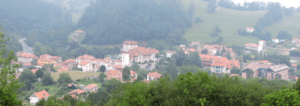Puente Viesgo facts for kids
Quick facts for kids
Puente Viesgo
|
|||
|---|---|---|---|
 |
|||
|
|||
| Country | Spain | ||
| Autonomous community | Cantabria | ||
| Province | Cantabria | ||
| Comarca | Valles Pasiegos | ||
| Area | |||
| • Total | 36.14 km2 (13.95 sq mi) | ||
| Elevation | 71 m (233 ft) | ||
| Highest elevation | 730 m (2,400 ft) | ||
| Lowest elevation | 70 m (230 ft) | ||
| Population
(2018)
|
|||
| • Total | 2,868 | ||
| • Density | 79.358/km2 (205.54/sq mi) | ||
| Demonym(s) | Spanish: torancés (m.), torancesa (f.) | ||
| Time zone | UTC+1 (CET) | ||
| • Summer (DST) | UTC+2 (CEST) | ||
| Official language(s) | Spanish | ||
Puente Viesgo is a small town and municipality in Cantabria, a region in northern Spain. It is famous for its amazing ancient caves filled with rock art and tools from the Stone Age. These discoveries tell us a lot about people who lived there thousands of years ago!
Contents
History of Puente Viesgo
The area around Puente Viesgo has been known for a very long time. Old documents from the year 1000 mention a bridge over the River Pas. This bridge is so important that the town's name, Puente Viesgo, actually means "Viesgo Bridge" in Spanish!
Caves of Monte Castillo
Ancient Art in the Caves
Puente Viesgo is home to the incredible Caves of Monte Castillo. These caves are like a giant art gallery from the Stone Age! They contain some of the oldest cave paintings ever found.
The Cave of El Castillo
The Cave of El Castillo was found in 1903 by a Spanish archaeologist named Hermilio Alcalde del Río. Later, a German expert, Hugo Obermaier, explored and dug up the cave. More digging happened in 1980.
Inside, you can see paintings of bison and horses. There are also many handprints. These handprints were made by blowing mineral dust onto a hand pressed against the cave wall. Scientists believe these are the oldest examples of rock art in this region.
Dating the Cave Art
It was tricky to figure out how old the paintings were. The colors used didn't have anything organic (like plants or animals) that could be dated. So, scientists looked at the calcium carbonate. This is a natural layer that formed over the paintings. By checking the age of this layer, they found that one red circle painting is about 40,800 years old!
The Cueva de las Monedas
Another amazing cave nearby is the Cueva de las Monedas. The paintings here are black, made with coal. They show horses, goats, bears, bison, and reindeer. The pictures of reindeer are thought to be from the last ice age, around 13,000 years ago.
Cueva de La Pasiega
The Cueva de La Pasiega is also in Puente Viesgo. It is part of a special group of caves that are a World Heritage Site. This site includes the famous "Cave of Altamira and palaeolithic cave art of Northern Spain."
Geography of Puente Viesgo
Puente Viesgo is located in the middle of Cantabria, a region in northern Spain. It sits in the valley of the River Pas. The town is about 30 kilometers (19 miles) west of Santander, which is the capital city of the region.
The area around Puente Viesgo is very green and beautiful. It's located between the Bay of Biscay to the north and the Cantabrian Mountains to the south.
Economy and Villages
For a long time, people in Puente Viesgo worked in farming. But now, many people work in tourism. This is because of the famous caves and the beautiful scenery.
The municipality of Puente Viesgo includes several small villages. These are Aés, Hijas, Las Presillas, Puente Viesgo (the main town), and Vargas. In 2018, about 2,868 people lived in the municipality.
Gallery
See also
 In Spanish: Puente Viesgo para niños
In Spanish: Puente Viesgo para niños









